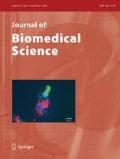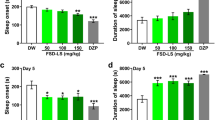Summary
The sedative-hypnotic medications, including benzodiazepines and non-benzodiazepines, are the most common treatments for insomnia. However, concerns regarding patterns of inappropriate use, dependence and adverse effects have led to caution in prescribing those sedative-hypnotic medications. On the other hand, a traditional Chinese herb remedy, suanzaorentang, has been efficiently and widely used in clinic for insomnia relief without severe side effects in Asia. Although suanzaorentang has been reported to improve sleep disruption in insomniac patients, its mechanism is still unclear. The present study was designed to elucidate the effects of oral administration of suanzaorentang on physiological sleep-wake architectures and its underlying mechanism in rats. We found that oral administration of suanzaorentang at the beginning of the dark onset dose-dependently increased non-rapid eye movement sleep (NREMS) during the dark period, but had no significant effect on rapid eye movement sleep (REMS). Our results also indicated that intracerebroventricular (ICV) administration of γ-aminobutyric acid (GABA) receptor type A antagonist, bicuculline, significantly blocked suanzaorentang-induced enhancement in NREMS during the dark period, but GABAB receptor antagonist, 2-hydroxysaclofen had no effect. These results implicated that this traditional Chinese herb remedy, suanzaorentang increases spontaneous sleep activity and its effects may be mediated through the GABAA receptors, but not GABAB receptors.
Similar content being viewed by others
References
Partinen M. (1994) Epidemiology of sleep disorders. In: Kryger M.H., Roth T., Dement W.C. (Eds) Principles and Practice of Sleep Medicine. Philadelphia: WB Saunders pp 437–452
Gillin J.C. (1998) Are sleep disturbances risk factors for anxiety, depressive and addictive disorders? [Review]. Acta Psychiatricia Scandinavica Supplementum. 393: 39–43
Chung K.F., Lee C.K.Y. (2002) Over-the-counter sleeping pills: a survey of use in Hong Kong and a review of their constituents. Gen. Hospital Psychiatry. 24: 430–435
Chen H.C., Hsieh M.T. (1985) Clinical trial of suanzaorentang in the treatment of insomnia. Clin. Therapeut.. 7: 334–337
Chen H.C., Hsieh M.T., Shibuya T. (1986) Suanzaorentang versus diazepam: a controlled double-blind study in anxiety. Int. J. Clin. Pharmacol, Therapy Toxicol.. 24: 646–650
Park J.H., Lee H.J., Koh S.M., Ban J.Y., Seong Y.H. (2004) Protection of NMDA-induced neuronal cell damage by methanol extract of Zizyphi Spinosi Semen in cultured rat cerebellar granule cells. J. Ethnopharmacol. 95: 39–45
Zheng H.Z., Dong A.H., and She J. (1997) (Eds) Modern Study of Traditional Chinese Medicine (in Chinese), Xue Yuan Press, Beijing, 1997
Kanba S., Yamada K., Mizushima H., Murata T., Asai M. (1999) Use of herbal medicine for treating psychiatric disorders in Japan. In: Kanba S., Richelson E. (Eds) Herbal Medicines for Neuropsychiatric Diseases: Current Developments and Research, New York: Brunner/Mazel, p. 3–14
Yu S.J., Tseng J. (1996) Fu-ling, a Chinese herbal drug, modulates cytokine secretion by human peripheral blood monocytes. Int. J. Immunopharmacol.. 18: 37–44
Liao S.L., Kao T.K., Chen W.Y., Lin Y.S., Chen S.Y., Raung S.L., Wu C.W., Lu H.C., Chen C.J. (2004) Tetramethylpyrazine reduces ischemic brain injury in rats. Neurosci. Lett.. 372: 40–45
Tsukamoto S., Wakana T., Koimaru K., Yoshida T., Sato M., Ohta T. (2005) 7-Hydroxy−3-(4-hydroxybenzyl)chroman and Broussonin B: Neurotrophic compounds, isolated from Anemarrhena asphodeloides Bunge, function as proteasome inhibitors. Biol. Pharmaceut. Bull.. 28: 1798–1800
Tsuda T., Kubota K., Yasuda K., Nishikawa S., Sugaya A., Sugaya E. (1986) Effects of Chinese herbal medicine “kanbaku-taiso-to” on transmembrane ionic currents and its local anesthetic action. J. Ethnopharmacol.. 17: 257–261
Liao J.F., Jan Y.M., Huang S.Y., Wang H.H., Yu L.L., Chen C.F. (1995) Evaluation with receptor binding assay on the water extracts of ten CNS-active Chinese herbal drugs. Proc. Natl. Sci. Council, ROC – Part B, Life Sci.. 19: 151–158
McGinty D., Szymusiak R. (2003) Hypothalamic regulation of sleep and arousal. Frontier. Biosci.. 8: s1074–s1083
Kukko-Lukjanov T.K., Panula P. (2003) Subcellular distribution of histamine, GABA and galanin in tuberomamillary neurons in vitro. J. Chem. Neuroanatomy. 25: 279–292
Chang F.-C., Opp M.R. (1998) Blockade of corticotropin-releasing hormone receptors reduces spontaneous waking in the rat. Am J Physiol 275: R793-R802
Epstein A.M., Fitzsimons J.T., Rolls B.J. (1970) Drinking induced by injection of angiotensin into the brain of the rat. J. Physiol.. 210: 457–474
Borbely A.A. (1982) A two process model of sleep regulation. Hum. Neurobiol.. 1: 195–204
Yi P.L., Tsai C.H., Lu M.K., Liu H.J., Chen Y.C., and Chang F.C. Interleukin−1β mediates sleep alteration in rotenone-induced parkinsonism rats. Sleep (under review process), 2006
Hsieh M.T., Chen H.C., Kao H.C., Shibuya T. (1986) Suanzaorentang and anxiolytic Chinese medicine, affects the central adrenergic and serotonergic systems in rats. Proc. Natl. Sci. Council, ROC –Part B, Life Sci.. 10: 263–268
Li Y., Wang R., Chen M., Wang Z., Bi K. (2001) Pharmacodynamics study of suanzaoren decoction extracted by different technological process Zhong Yao Cai 24: 884–885
Hansen M.K., Kapas L., Fang J., Krueger J.M. (1998) Cafeteria diet-induced sleep is blocked by subdiaphragmatic vagotomy in rats. Am. J. Physiol.. 274: R168-R174
Jenkins J.B., Omori T., Guan Z., Vgontzas A.N., Bixler E.O., Fang J. (2006) Sleep is increased in mice with obesity induced by high-fat food. Physiol. Behav.. 87: 255–262
Roky R., Kapas L., Taishi P., Fang J., Krueger J.M. (1999) Food restriction alters the diurnal distribution of sleep in rats. Physiol. Behav. 67: 697–703
Rizzo P., Beelke M., De Carli F., Canovaro P., Nobili L., Robert A., Fornaro P., Tanganelli P., Regesta G., Ferrillo F. (2004) Modifications of sleep EEG induced by chronic vagus nerve stimulation in patients affected by refractory epilepsy. Clin. Neurophysiol. 115: 658–664
Valdes-Cruz A., Magdaleno-Madrigal V.M., Martinez-Vargas D., Fernandez-Mas R., Almazan-Alvarado S., Martinez A., Fernandez-Guardiola A. (2002) Chronic stimulation of the cat vagus nerve: effect on sleep and behavior Prog. Neuro-Psychopharmacol. Biol. Psychiatry. 26: 113–118
Vgontzas A.N., Papanicolaou D.A., Bixler E.O., Chrousos G.P. (1997) Elevation of plasma cytokines in disorders of excessive daytime sleepiness: Role of sleep disturbance and obesity. J. Clin. Endocrinol. Metab.. 82: 1313–1316
Kubota T., Fang J., Guan Z., Brown R.A., Krueger J.M. (2001) Vagotomy attenuates tumor necrosis factor-alpha-induced sleep and EEG delta-activity in rats. Am. J. Physiol. – Regulat. Integr. Comp. Physiol.. 280: R1213-R1220
Graeff F.G., Netto C.F., Jr. Zangrossi H. (1998) The elevated T-maze as an experimental model of anxiety Neurosci. Biobehav. Rev. 23: 237–246
Ripoll N., Hascoet M., Bourin M. (2006) Implication of 5-HT2 A subtype receptors in DOI activity in the four-plates test-retest paradigm in mice. Behav Brain Res. 166: 131–139
Hilakivi I., Kovala T., Lappavuori A., Shvaloff A. (1987) Effects of serotonin and noradrenaline uptake blockers on wakefulness and sleep in cats. Pharmacol. Toxicol.. 60: 161–166
Nicholson A.N., Pascoe P.A. (1986) 5-Hydroxytryptamine and noradrenaline uptake inhibition: studies on sleep in man. Neuropharmacology.25: 1079–1083
Monti J.M., Jantos H. (2004) Effects of the 5-HT1 A receptor ligands flesinoxan and WAY 100635 given systemically or microinjected into the laterodorsal tegmental nucleus on REM sleep in the rat. Behav. Brain Res.. 151: 159–166
Popa D., Lena C., Fabre V., Prenat C., Gingrich J., Escourrou P., Hamon M., Adrien J. (2005) Contribution of 5-HT2 receptor subtypes to sleep-wakefulness and respiratory control, and functional adaptations in knock-out mice lacking 5-HT2 A receptors. J. Neurosci.. 25: 11231–11238
Mendelson W.B. (1985) GABA-benzodiazepin-receptor chloride ionophore complex: Implications for the pharmacology of sleep. In: Wauquier A., Monti J.M., Gaillard J.M. (eds) Sleep Neurotransmitters and Neuromodulators, New York: Raven Press, p. 229
Gottesmann C. (2002) GABA mechanisms and sleep. Neuroscience. 111: 231–239
Faulhaber J., Steiger A., Lancel M. (1997) The GABAA agonist THIP produces slow wave sleep and reduces spindling activity in NREM sleep in humans. Psychopharmacology. 130: 285–291
Von Krosigk M., Bal T., McCormick D.A. (1993) Cellular mechanisms of a synchronized oscillation in thalamus. Science. 261: 361–364
Borbely A.A., Mattmann P., Loepfe M., Strauch I., Lehmann D. (1985) Effects of benzodiazepine hypnotics on all-night sleep EEG spectra. Hum. Neurobiol.. 4: 189–194
Gaillard J.M., Schultz P., Tissot R. (1973) Effects of three benzodiazepines (nitrazepam, flunitrazepam and bromazepam) on sleep of normal subjects, studied with an automatic scoring system. Pharmakopsychiatrie. 6: 207–217
Lancel M., Gronlein T.A.M., Faulhaber J. (1996) Role of GABAA receptors in sleep regulation. Differential effects of muscimol and midazolam on sleep in rat. Neuropsychopharmacology. 15: 63–74
Mendelson W.B, Martin J.V. (1990) Effects of muscimol and flurazepam on the sleep EEG in the rat. Life. Sci.. 47: 99–101
Monti J.M., Altier H. (1973) Flunitrazepam (Ro 5–4200) and sleep cycle in normal subjects. Psychopharmacologia. 32: 343–349
Gandolfo G., Scherschlicht R., Gottesmann C. (1994) Benzodiazepines promote the intermediate stage at the expense of paradoxical sleep in the rat. Pharmacol. Biochem. Behav.. 49: 921–927
Borbely A.A., Achermann P. (1991) Ultradian dynamics of sleep after a single dose of benzodiazepine hypnotics Eur. J. Pharmacol. 195: 11–18
Tobler I., Kopp C., Deboer T., Rudolph U. (2001) Diazepam-induced changes in sleep: role of the alpha 1 G ABAA receptor subtype. Proc. Natl. Acad. Sci. USA. 98: 6464–6469
Declerck A.C., Ruwe F., O’Hanlon J.F., Wauquier A. (1992) Effects of zolpidem and flunitrazepam on nocturnal sleep of women subjectively complaining of insomnia. Psychopharmacology. 106: 497–501
Depoortere H., Francon D., Van Luijtelaar E.L.J.M., Drinkenburg W.H.I.M., Coenen A.M.L. (1995) Differential effects of midazolam and zolpidem on sleep-wake states and epileptic activity in WAG/Rij rats. J. Pharmacol. Exp. Ther.. 237: 649–658
Gottesmann C., Trefouret S., Depoortere H. (1994) Influence of Zolpidem, a novel hypnotic, on the intermediate stage and paradoxical sleep in rat. Pharmacol. Biochem. Behav.. 47: 359–362
Juhasz G., Emri Z., Kekesi K.A., Salfay O., Crunelli V. (2004) Blockade of thalamic GABAB receptors decreases EEG synchronization. Neurosci. Lett.. 172: 155–158
Johnston G.A.R. (1986) Multiplicity of GABA receptors. In: Olsen R.W., Venter J.C. (Eds) Benzodiazepine/GABA Receptors and Chloride Channels: Structural and Functional Properties. New York: Alan R. Liss, Inc., p. 57–71
Enz R., Brandstatter J.H., Hartveit E., Wassle H., Bormann J. (1995) Expression of GABA receptor rho 1 and rho 2 subunits in the retina and brain of rat. Eur. J. Neurosci.. 7: 1495–1501
Boue-Grabot E., Taupignon A., Tramu G., Garret M. (2000) Molecular and electrophysiological evidence for a GABAC receptor in thyrotropin-secreting cells. Endocrinology. 141: 1627–1632
Arnaud C., Gauthier P., Gottesmann C. (2001) Study of GABAC receptor antagonist on sleep-wake behavior in rats. Psychopharmacology. 154: 415–419
Acknowledgements
This work was supported by the National Science Council grant NSC94-2320-B-002–126, and China Medical University grants DMR94–058.
Author information
Authors and Affiliations
Corresponding author
Rights and permissions
About this article
Cite this article
Yi, PL., Tsai, CH., Chen, YC. et al. Gamma-aminobutyric acid (GABA) receptor mediates suanzaorentang, a traditional Chinese herb remedy, -induced sleep alteration. J Biomed Sci 14, 285–297 (2007). https://doi.org/10.1007/s11373-006-9137-z
Received:
Accepted:
Published:
Issue Date:
DOI: https://doi.org/10.1007/s11373-006-9137-z




